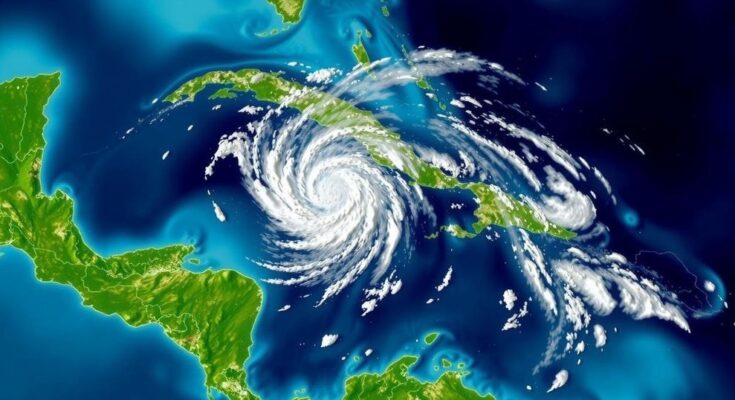Tropical Storm Sara has formed in the Western Caribbean, threatening northern Honduras with rainfall between 10 to 20 inches. This season has seen above-average storm activity, with Sara likely to become a weak tropical cyclone after landfall. Historical context highlights the severe impact of hurricanes on Honduras, driving migration and economic strain, necessitating increased attention to climate change’s effects.
Tropical Storm Sara developed from Tropical Depression 19 in the Western Caribbean on November 14, 2024, marking the 18th named storm of the Atlantic hurricane season. This season has thus far surpassed the average for named storms, hurricanes, and major hurricanes. Despite moving at 12 mph with winds of 40 mph, Sara’s trajectory poses considerable risks for northern Honduras, forecasted to receive between 10 to 20 inches of rain, potentially causing severe flooding and landslides. Following a prolonged period of inaction in the Atlantic, recent weeks have seen an unusual uptick in storm activity. The storm is projected to move slowly westward, making landfall near Honduras, but its interaction with land could hinder its intensification. Models indicate that the storm could transition to a weak tropical cyclone as it enters the Gulf of Mexico later in the week, diminishing its threat level. Sara’s impacts are particularly concerning for Honduras, a country still grappling with the repercussions of previous hurricanes that resulted in decimating floods and extensive infrastructure damage. Honduras has a tragic history of suffering from late-season tropical cyclones, notably Hurricane Mitch, which caused over 11,000 fatalities in 1998. More recently, hurricanes Eta and Iota devastated the region, wreaking economic havoc and displacing thousands. Climate-related disasters are intimately linked to increased migration patterns from Honduras to the U.S., as environmental factors continue to displace and threaten livelihoods. According to advocacy groups, a significant percentage of migrants cite such environmental factors as drivers of their migration, underlining the urgency for greater climate awareness and action.
The article discusses the formation and implications of Tropical Storm Sara in the Western Caribbean. This phenomenon occurs within a hyperactive Atlantic hurricane season characterized by an exceptionally high number of named storms. The conditions leading to Sara’s formation underscore the impact of a warming climate, and the discourse surrounding the storm emphasizes the history of devastating impacts from previous hurricanes on Honduras and the broader implications for migration as a consequence of repeated climatic disasters. The situation is compounded by the socioeconomic vulnerabilities currently faced by the region’s population, resulting from past hurricanes and the ongoing climate crisis.
In summary, Tropical Storm Sara poses imminent threats to Honduras, potentially triggering catastrophic flooding and exacerbating the region’s ongoing recovery from previous hurricanes. The high frequency of storms reflects shifts in climate patterns, which have dire implications for the population’s safety, stability, and migration tendencies. A heightened awareness of climate change effects is essential, as it affects both regional resilience and international responses to the challenges faced by countries like Honduras.
Original Source: yaleclimateconnections.org




